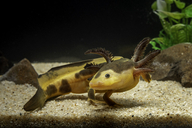|
Ambystoma amblycephalum Taylor, 1940
Blunt-headed Salamander Subgenus: Heterotriton | family: Ambystomatidae genus: Ambystoma |
| Species Description: Taylor, E. H. 1940 "1939". New salamanders from Mexico, with a discussion of certain known forms. University of Kansas Science Bulletin 26: 407–430. | |
|
Etymology: The specific epithet of A. amblycephalum likely translated to “blunt head” coming from the Greek roots “ambly” meaning “blunt” and “cephalo” meaning “head”. |
|
 © 2023 Saulo Cortes (1 of 3) |
|
|
|
Description DIAGNOSIS: (How this species is different from similar species) Ambystoma amblycephalum has 11 costal grooves compared to 13 in A. flavipiperatum (Hernandez et al. 2022). They are larger than A. velasci and A. bombypellum and have different body proportions, such as how A. amblycephalum has a less compressed body than A. lermaense. The tail in A. amblycephalum is smaller compared to A. flavipiperatum. A greater number of premaxillary teeth are present in this species than others (around 70). Ambystoma amblycephalum possesses darker and more olive colored spots than A. velasci and possesses light ventral spots, which A. lermaense lacks. Ambystoma ordinarium lacks the webbing present on the base of the toes that A. amblycephalum possesses (Taylor 1940). COLORATION: Metamorphosed individuals are blackish dorsally with cream or olive spots on the lower sides and tail, while the venter is lighter with cream colored markings (Taylor and Smith 1945). Paedomorphic adults are lighter than larvae, often with a greenish-yellow background with dark markings, although some have been found to have a grayish background with large cream blotches (Fraustros-Sandoval et al. 2024). VARIATION: Besides size, there is some sexual dimorphism as females don’t have very pronounced markings (Taylor 1940). Additionally, a paedomorphic specimen observed by Fraustros-Sandoval et al. (2024) changed color over the course of almost a year. Color changes like this are associated with adaptation to temperature and other environmental factors. The abnormal coloration seen in these specimens could have been due to the pollution of the pond they inhabited. Distribution and Habitat Country distribution from AmphibiaWeb's database: Mexico
Life History, Abundance, Activity, and Special Behaviors Potential clutches of this species were comprised of 170 - 220 eggs in single masses laid on roots/other vegetation (Hernandez et al. 2022). Larva Coloration consists of red gills, and a black background with small light spots on the side (Taylor and Smith 1945). Larvae of A. amblycephalum resemble A. velasci, but have different coloration (Taylor and Smith 1945). The larvae most likely consume aquatic insects and their larvae such as Daphnia and Chironomus, which have been observed nearby (Hernandez et al. 2022). Trends and Threats A new population was discovered in a cattle pond near Nahuatzen in 2018 (Hernandez et al. 2022). Relation to Humans Possible reasons for amphibian decline General habitat alteration and loss Comments Ambystoma amblycephalum has only been genetically confirmed two times since first being described in 1940 (Hernandez et al. 2022). OTHER INTERESTING INFORMATION: References Fraustros-Sandoval, A. J., Dávalos-Martínez, A., Rosas-Espinoza, V. C., Cortés-Arévalo, S. A., Navarrete Heredia, J. L., and Santiago-Pérez, A. L. (2024). A temporal color variant in the Blunt-headed Salamander (Ambystoma amblycephalum) in west-central Mexico. Western North American Naturalist 84(1), 158–162. [link] Hernandez, A., Dufresnes, C., Raffaëlli, J., Jelsch, E., Dubey, S., Santiago-Pérez, A. L., Rosas-Espinoza, V. C., and Nuñez, P. B. (2022). Hope in the dark: Discovery of a population related to the presumably extinct micro-endemic blunt-headed salamander (ambystoma amblycephalum). Neotropical Biodiversity, 8(1), 35–44. [link] Taylor, E. H. (1940). New salamanders from Mexico, with a discussion of certain known forms. University of Kansas Science Bulletin 26, 407–430. [link] Taylor, E. H., and Smith, H. M. (1945). Summary of the collections of amphibians made in Mexico under the Walter Rathbone Bacon traveling scholarship. Proceedings of the United States National Museum, 95(3185), 521–613. [link]
Originally submitted by: Torsten Watkins (2024-03-21) Description by: Torsten Watkins (updated 2024-03-21)
Distribution by: Torsten Watkins (updated 2024-03-21)
Life history by: Torsten Watkins (updated 2024-03-21)
Larva by: Torsten Watkins (updated 2024-03-21)
Trends and threats by: Torsten Watkins (updated 2024-03-21)
Relation to humans by: Torsten Watkins (updated 2024-03-21)
Comments by: Torsten Watkins (updated 2024-03-21)
Edited by: Ann T. Chang (2024-08-22) Species Account Citation: AmphibiaWeb 2024 Ambystoma amblycephalum: Blunt-headed Salamander <https://amphibiaweb.org/species/3823> University of California, Berkeley, CA, USA. Accessed May 9, 2025.
Feedback or comments about this page.
Citation: AmphibiaWeb. 2025. <https://amphibiaweb.org> University of California, Berkeley, CA, USA. Accessed 9 May 2025. AmphibiaWeb's policy on data use. |


 Raffaëlli Account
Raffaëlli Account Map of Life
Map of Life